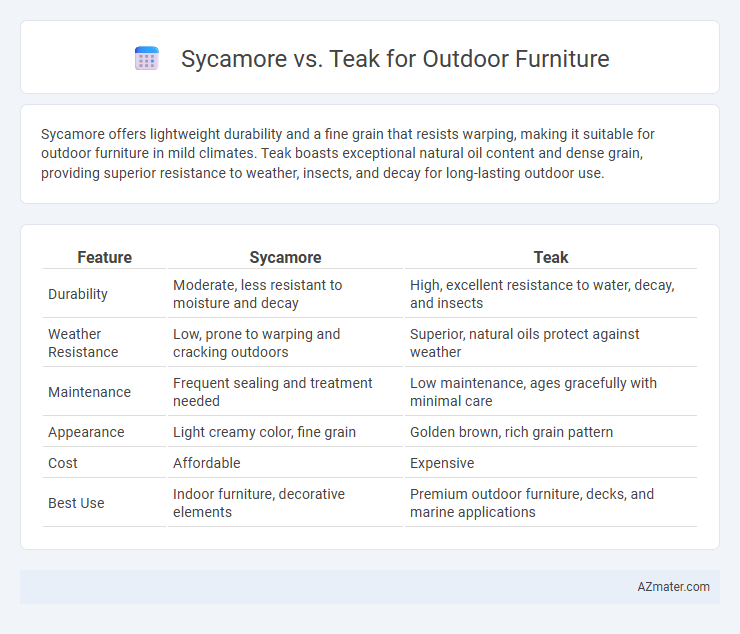Sycamore offers lightweight durability and a fine grain that resists warping, making it suitable for outdoor furniture in mild climates. Teak boasts exceptional natural oil content and dense grain, providing superior resistance to weather, insects, and decay for long-lasting outdoor use.
Table of Comparison
| Feature | Sycamore | Teak |
|---|---|---|
| Durability | Moderate, less resistant to moisture and decay | High, excellent resistance to water, decay, and insects |
| Weather Resistance | Low, prone to warping and cracking outdoors | Superior, natural oils protect against weather |
| Maintenance | Frequent sealing and treatment needed | Low maintenance, ages gracefully with minimal care |
| Appearance | Light creamy color, fine grain | Golden brown, rich grain pattern |
| Cost | Affordable | Expensive |
| Best Use | Indoor furniture, decorative elements | Premium outdoor furniture, decks, and marine applications |
Introduction: Sycamore vs Teak for Outdoor Furniture
Sycamore and teak are popular choices for outdoor furniture, each offering distinct durability and aesthetic qualities. Teak contains natural oils and dense grain, providing superior resistance to moisture, insects, and weathering, making it ideal for long-lasting outdoor use. Sycamore, while more affordable and lighter in weight, requires regular sealing and maintenance to withstand outdoor conditions effectively.
Wood Characteristics: Sycamore vs Teak
Sycamore wood is light-colored with a fine, uniform texture and moderate durability, making it less resistant to outdoor elements compared to teak. Teak wood is renowned for its high oil content, tight grain, and exceptional natural resistance to decay, insects, and moisture, which contribute to its long-lasting performance in outdoor furniture. The dense structure and weatherproof qualities of teak make it a preferred choice for outdoor settings, whereas sycamore requires protective treatments to withstand the same conditions.
Durability and Weather Resistance
Teak wood is highly prized for outdoor furniture due to its exceptional durability and natural oils that provide superior weather resistance, allowing it to withstand moisture, heat, and insect damage. Sycamore, while moderately durable, is less resistant to outdoor elements, making it more susceptible to swelling, cracking, and decay when exposed to prolonged moisture and fluctuating temperatures. Selecting teak ensures long-term performance and minimal maintenance in harsh outdoor environments, whereas sycamore may require frequent sealing and protection to maintain its structural integrity.
Maintenance Requirements
Sycamore outdoor furniture requires moderate maintenance, including regular sealing and protection from prolonged moisture exposure to prevent warping and cracking. Teak, known for its natural oil content, offers superior resistance to rot and insects, requiring minimal upkeep beyond occasional cleaning and oiling to maintain its golden hue. Choosing teak reduces long-term maintenance efforts, while sycamore demands more consistent care for durability in outdoor environments.
Appearance and Aesthetic Appeal
Sycamore wood offers a lighter, creamy color with intricate grain patterns, creating a natural and elegant look ideal for modern outdoor furniture designs. Teak is prized for its rich golden-brown hue and tight, straight grain, providing a warm, luxurious aesthetic that ages gracefully into a silvery-gray patina. The distinct tonal qualities of sycamore emphasize brightness and subtle texture, while teak delivers durability combined with a classic, timeless charm in outdoor settings.
Cost Comparison
Sycamore wood generally costs less than teak, making it a budget-friendly option for outdoor furniture without compromising durability. Teak's high oil content and natural resistance to weather make it more expensive, but this translates to longer-lasting furniture with minimal maintenance. When comparing Sycamore vs Teak, consider initial investment versus long-term value, as teak offers superior longevity despite its higher upfront cost.
Sustainability and Environmental Impact
Sycamore wood offers a sustainable choice for outdoor furniture due to its fast growth and widespread availability, reducing the pressure on natural forests. Teak, while highly durable and resistant to weather, often comes from slower-growing trees, raising concerns about deforestation and illegal logging in some regions. Choosing FSC-certified sources for both sycamore and teak can minimize environmental impact and promote responsible forestry practices.
Workability and Construction
Sycamore offers excellent workability due to its fine, even grain and moderate hardness, making it easy to cut, shape, and sand for intricate outdoor furniture designs. Teak, known for its dense, oily texture, requires sharper tools and more effort during construction but provides superior durability and natural resistance to weather and pests. While sycamore is ideal for detailed craftsmanship, teak's natural oils make it a preferred choice for long-lasting outdoor furniture despite its tougher workability.
Common Uses in Outdoor Furniture
Sycamore wood is commonly used for outdoor furniture such as benches, garden tables, and decorative chairs due to its fine grain and smooth finish which offers moderate durability in dry climates. Teak is highly favored for outdoor furniture including patio sets, dining tables, and loungers because of its exceptional resistance to weather, moisture, and insects, ensuring longevity in various outdoor environments. Both woods are chosen for their aesthetic appeal, but teak's natural oils make it a superior choice for long-term outdoor use.
Final Verdict: Choosing Between Sycamore and Teak
Teak offers unmatched durability and natural resistance to outdoor elements, making it ideal for long-lasting outdoor furniture despite its higher cost. Sycamore is more affordable and visually appealing with its lighter, consistent grain but requires regular maintenance to withstand weather exposure. Choosing between sycamore and teak depends on budget, maintenance willingness, and desired longevity for outdoor furniture use.

Infographic: Sycamore vs Teak for Outdoor Furniture
 azmater.com
azmater.com